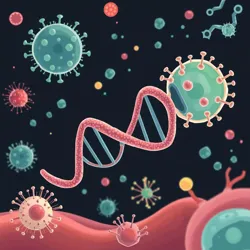Genetic Breakthroughs in Microbe Adaptation
 An illustration depicting the genetic adaptation mechanisms in microbes.
An illustration depicting the genetic adaptation mechanisms in microbes.Recent advancements in genetic research have unveiled fascinating insights into the rapid adaptation capabilities of microscopic organisms, often referred to as "microscopic monsters." These findings have profound implications for our understanding of how life can thrive under extreme conditions and offer potential applications in biotechnology and environmental science.
Overview
Microbes are renowned for their ability to adapt swiftly to changing environments, a trait that has intrigued scientists for decades. The genetic mechanisms behind this adaptability are now being unraveled, revealing complex processes that enable these organisms to survive and flourish in some of the harshest conditions on Earth.
Mechanisms of Adaptation
Several key mechanisms have been identified that contribute to the remarkable adaptability of microbes:
Horizontal Gene Transfer
One of the most significant processes is horizontal gene transfer, where genetic material is exchanged between different microbial species. This allows microbes to acquire beneficial genes rapidly, enhancing their ability to adapt to environmental changes such as increased temperatures or exposure to toxins.
Mutation and Selection
Microbes also benefit from high mutation rates, which generate genetic diversity within populations. Natural selection then acts on this diversity, favoring individuals with advantageous traits. This process is particularly evident in environments like geothermal vents, where organisms such as Thermo Gliders have evolved heat-resistant proteins.
Gene Duplication
Gene duplication is another important adaptation strategy. By duplicating existing genes, microbes can explore new functions without losing essential capabilities. This has been observed in Invincible Minutiae, where duplicated genes have contributed to their resilience against both radiation and desiccation.
Implications and Applications
The study of genetic adaptation in microbes has wide-ranging implications:
Environmental Resilience
Understanding these genetic mechanisms can help predict how microbial communities will respond to environmental changes, such as climate change or pollution. This knowledge is critical for preserving ecosystems and maintaining biodiversity.
Bioengineering and Biotechnology
The insights gained from microbial adaptation are being applied to bioengineering, where researchers aim to develop synthetic organisms with enhanced capabilities. For example, heat-resistant proteins from Thermo Gliders are being studied for use in industrial processes that operate at high temperatures.
Astrobiology
The genetic resilience of extremophiles offers models for potential life on other planets. By studying these organisms, scientists can better understand how life might adapt to extraterrestrial environments, guiding future missions in the search for life beyond Earth.
Future Research
Ongoing research into microbial genetics promises to uncover further breakthroughs. Areas of interest include the role of epigenetics in adaptation and the potential for engineering microbes to aid in environmental remediation or space exploration.
See Also
- Thermo Gliders
- Invincible Minutiae: Life Beyond Tardigrades
- Heat-Resistant Microbial Ecosystems
References
- "Microbial Genetics and Environmental Adaptation," Journal of Applied Microbiology, 2019.
- "Evolutionary Dynamics in Microbial Communities," Ecological Genetics Quarterly, 2021.
- "Biotechnological Applications of Microbial Adaptation," Industrial Biotechnology Journal, 2022.
These genetic breakthroughs not only enhance our understanding of life's adaptability but also pave the way for innovative applications that could transform various scientific fields.